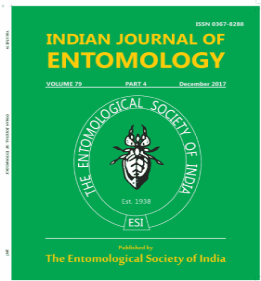Behavioural and Electrophysiological Response of Trichogramma achaea to Oviposition Induced Volatiles in Tomato
DOI:
https://doi.org/10.55446/IJE.2023.1150Keywords:
Trichogramma achaea, conspecifics, heterospecifics, choice and no-choice parasitization assay, olfactometer studie, EAD active compound, Tuta absoluta, volatile organic compounds, electrophysiological compounds, antennal responseAbstract
A laboratory experiment was conducted at ICAR-National Bureau of Agricultural Insect Resources, Bengaluru to study the behavioural response of Trichogramma achaea towards healthy, conspecifics (Tuta absoluta oviposited on Tuta absoluta infested plants) and heterospecifics (Tuta absoluta oviposited on Liriomyza trifolii infested plants) tomato plants by choice and no-choice parasitization assays and olfactometer studies. Headspace volatiles were collected from tomato plants oviposited by conspecifics, heterospecifics and healthy plants, analysed using gas chromatography-mass spectrometry (GC-MS) where 14, 17 and 8 volatile organic compounds were detected respectively. Electrophysiological compounds and antennal response of T. achaea were identified using gas chromatography-electro-antennographic detector (GC-EAD). EAD active compounds of T. achaea were 3-Hexanol, α-phellandrene, trans-β- ocimene, pentacosane and γ-terpinene.
Downloads
Metrics
Downloads
Published
How to Cite
Issue
Section
References
Anastasaki E, Drizou F, Milonas P G. 2018. Electrophysiological and oviposition responses of Tuta absoluta females to herbivore-induced volatiles in tomato plants. Journal of Chemical Ecology 44 (3): 288-298.
Buttery R G, Ling L C, Light D M. 1987. Tomato leaf volatile aroma components. Journal of Agricultural and Food Chemistry 35 (6): 1039-1042.
Fatouros N E, BukovinszkineKiss G, Kalkers L A, Gamborena R S, Dicke M, Hilker M. 2005. Oviposition-induced plant cues: do they arrest Trichogramma wasps during host location. Entomologia Experimentalis et Applicata 115 (1): 207-215.
Gontijo L, Cascone P, Giorgini M, Michelozzi M, Rodrigues H S, Spiezia G, Iodice L, Guerrieri E. 2019. Relative importance of host and plant semiochemicals in the foraging behavior of Trichogramma achaeae, an egg parasitoid of Tuta absoluta. Journal of Pest Science 92 (4): 1479-1488.
Milonas P G, Anastasaki E, Partsinevelos G. 2019. oviposition-induced volatiles affect electrophysiological and behavioral responses of egg parasitoids. Insects 10.
White P R, Chamber J. 1989. The saw-toothed grain beetle Oryzaephilus surinamensis (Coleoptera: Silvanidae): Antenna and behavioural response to individual components and blends of aggregation pheromone. Journal of Chemical ecology 15: 1015-1031.
















